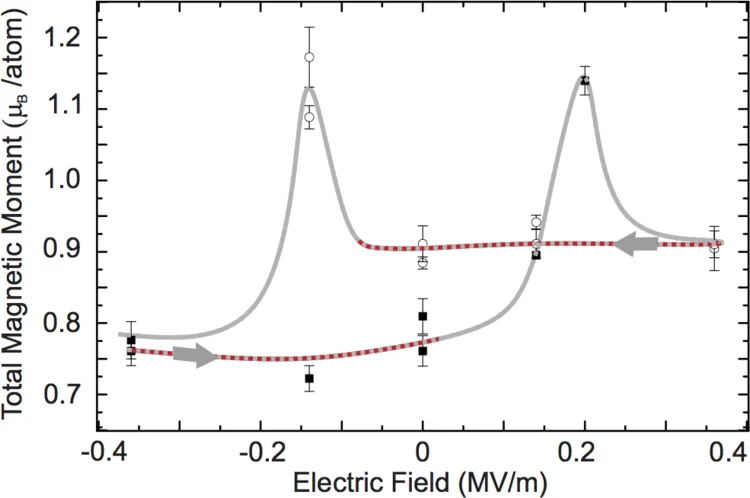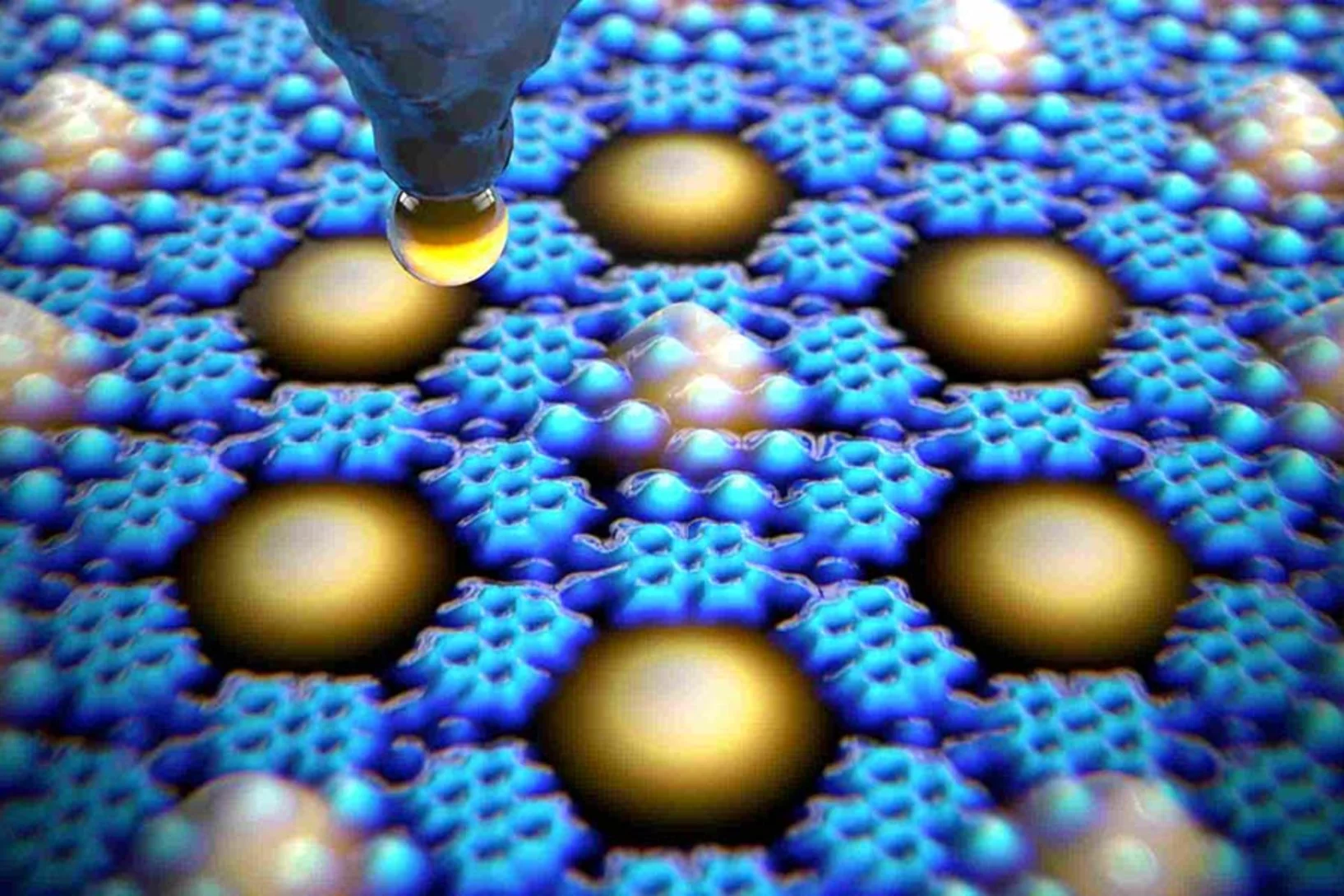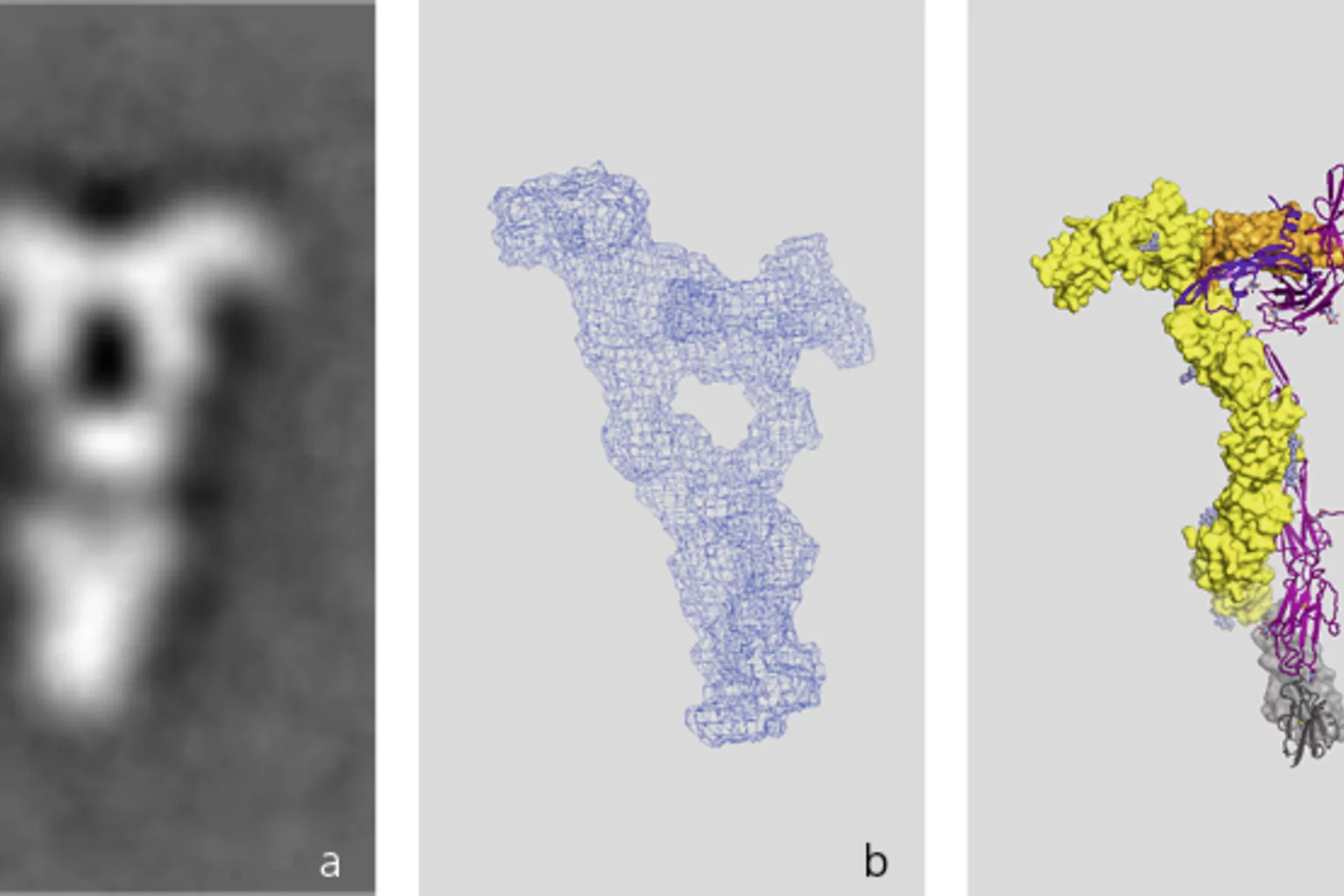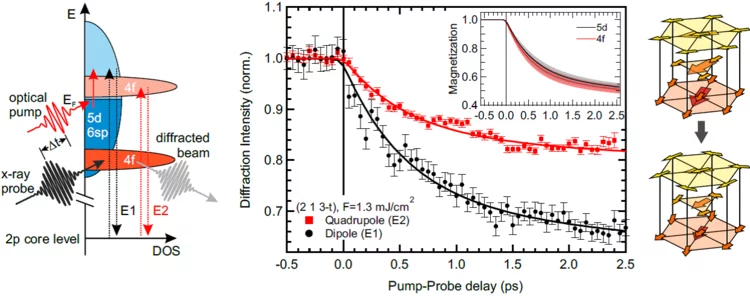At PSI, several projects are dedicated to important research questions concerning the Sars-CoV-2 coronavirus and the resulting diseases. We provide information on activities and projects, for example on investigations of lung tissue, on the production of proteins and antibodies or on ideas for new research on Covid-19.
Useful links
High-resolution hard x-ray magnetic imaging with dichroic ptychography
Imaging the magnetic structure of a material is essential to understanding the influence of the physical and chemical microstructure on its magnetic properties. Magnetic imaging techniques, however, have been unable to probe three-dimensional micrometer-size systems with nanoscale resolution. Here we present the imaging of the magnetic domain configuration of a micrometer-thick FeGd multilayer with hard x-ray dichroic ptychography at energies spanning both the Gd L3 edge and the Fe K edge, providing a high spatial resolution spectroscopic analysis of the complex x-ray magnetic circular dichroism.
Volume-wise destruction of the antiferromagnetic Mott insulating state through quantum tuning
RENiO3 (RE=rare-earth element) and V2O3 are archetypal Mott insulator systems. When tuned by chemical substitution (RENiO3) or pressure (V2O3), they exhibit a quantum phase transition (QPT) between an antiferromagnetic Mott insulating state and a paramagnetic metallic state. Because novel physics often appears near a Mott QPT, the details of this transition, such as whether it is first or second order, are important.
Call for expressions of interest: Beamline partners at the SLS for PX II and PX III
We invite companies and institutions to secure access to the beamlines X10SA/PX II and X06DA/PX III through a long term contract.
On the Interaction between Digitonin and Cholesterol in Langmuir Monolayers
In this article, we describe the effect of a highly hemolytic saponin, digitonin, on model lipids cholesterol and dipalmitoylphosphatidylcholine (DPPC) using a combination of tensiometric (surface pressure and dilatational surface elasticity), spectroscopic (infrared reflection absorption spectroscopy, IRRAS), microscopic (fluorescence microscopy), and scattering techniques (neutron reflectivity, NR, and grazing incidence X-ray diffraction, GIXD).
The deuteron too poses a mystery
The deuteron — just like the proton — is smaller than previously thoughtThe deuteron — one of the simplest atomic nuclei, consisting of just one proton and one neutron — is considerably smaller than previously thought. This new research finding fits with a 2010 study in which, similarly, the proton was measured at the Paul Scherrer Institute and, likewise, a smaller value than expected was found. The result from 2010 formed the basis for what has been known since then as the proton radius puzzle.
Low temperature activation of supported metathesis catalysts by organosilicon reducing agents
Industrial alkene metathesis processes rely on silica-supported tungsten oxide catalysts, which operate at high temperatures (>350 °C) due to the difficulty in generating active sites (carbenes or metallacyclobutanes). We report here a low temperature activation process of well-defined metal oxo surface species using organosilicon reductants, which generate a large amount of active species at only 70 °C (0.6 active sites/W).
Designer nuclide for medical applications
Researchers at the PSI have for the first time used a cyclotron to produce the radionuclide scandium-44 in a quantity and concentration as needed for medical treatment. With that, they have achieved the first precondition for scandium-44 to be used one day for medical tests in hospitals.
Phononic Structure Engineering: the Realization of Einstein Rattling in Calcium Cobaltate for the Suppression of Thermal Conductivity
Phonons in condensed matter materials transmit energy through atomic lattices as coherent vibrational waves. Like electronic and photonic properties, an improved understanding of phononic properties is essential for the development of functional materials, including thermoelectric materials. Recently, an Einstein rattling mode was found in thermoelectric material Na0.8CoO2, due to the large displacement of Na between the [CoO2] layers.
Physical realization of a quantum spin liquid based on a complex frustration mechanism
Unlike conventional magnets where the magnetic moments are partially or completely static in the ground state, in a quantum spin liquid they remain in collective motion down to the lowest temperatures. The importance of this state is that it is coherent and highly entangled without breaking local symmetries.
Iridates from the molecular side
New exotic phenomena have recently been discovered in oxides of paramagnetic Ir4+ ions, widely known as ‘iridates’. Their remarkable properties originate from concerted effects of the crystal field, magnetic interactions and strong spin-orbit coupling, characteristic of 5d metal ions.
Magnesium Oxide Boosts the Hysteresis of Single-Molecule Magnets
Researchers from PSI and EPFL have demonstrated that the magnetization hysteresis and remanence of TbPc2 single-molecule magnets drastically depends on the substrate on which they are deposited. If a few atomic layers thick magnesium oxide film grown on a silver substrate is used, a record wide hysteresis and record large remanence can be obtained. Single-molecule magnets are attractive for molecular spintronics applications such as information processing or storage.
A Mini-Antenna for the Data Processing of Tomorrow
The use of spin-wave signals in future information processing devices can substantially reduce power consumption over present charge current based technologies. As part of an international research venture, scientists at PSI now introduced a concept to generate spin waves with nanoscale wavelengths exploiting the driven dynamics of magnetic vortex cores in magnetic heterostructures.
Hitching a ride to gamma-ray bursts
Researchers at the PSI have developed a detector called POLAR. It is designed to search out and investigate extreme eruptions of energy from the depths of the universe. This coming September, POLAR will be launched into orbit with a Chinese space mission.
POLAR detector developed at the PSI flies into orbit with a Chinese space mission
Researchers working with Wojciech Hajdas at the Paul Scherrer Institute PSI have developed a detector called POLAR. This instrument is expected to search out and investigate so-called gamma ray bursts coming from the depths of the universe. Gamma ray bursts are eruptions of high-energy light that despite being extremely strong remain, up to now, only poorly understood.
Shedding light on the origins of high-Tc superconductivity in bismuth oxides
Researchers have overcome a number of challenges in order to employ an advanced probe in the study of an unusual material, barium bismuth oxide (BaBiO3) – an insulating parent compound of a family of high-temperature superconductors known since the late 80s. In order to finally realize the experiments, the researchers grew and studied thin films of the material completely in situ under ultrahigh vacuum conditions. The results show that superconductivity in bismuth oxides emerges out of a novel insulating phase, where hole pairs located on combinations of the oxygen orbitals are coupled with distortions of the crystal lattice.
Ferromagnetic Quantum Critical Point Avoided by the Appearance of Another Magnetic Phase in LaCrGe3 under Pressure
The temperature-pressure phase diagram of the ferromagnet LaCrGe3 is determined for the first time from a combination of magnetization, muon-spin-rotation, and electrical resistivity measurements. The ferromagnetic phase is suppressed near 2.1 GPa, but quantum criticality is avoided by the appearance of a magnetic phase, likely modulated, AFMQ.
Muon polarization in the MEG experiment: predictions and measurements
The MEG experiment makes use of one of the world’s most intense low energy muon beams, in order to search for the lepton flavour violating process μ+→e+γ . We determined the residual beam polarization at the thin stopping target, by measuring the asymmetry of the angular distribution of Michel decay positrons as a function of energy. The initial muon beam polarization at the production is predicted to be Pμ=−1Pμ=−1 by the Standard Model (SM) with massless neutrinos.
Momentum-Resolved Electronic Structure of the High-Tc Superconductor Parent Compound BaBiO3
We investigate the band structure of BaBiO3, an insulating parent compound of doped high-Tc superconductors, using in situ angle-resolved photoemission spectroscopy on thin films. The data compare favorably overall with density functional theory calculations within the local density approximation, demonstrating that electron correlations are weak. The bands exhibit Brillouin zone folding consistent with known BiO6 breathing distortions.
LUC at the Top of Europe
This years excursion took the members of the Laboratory of Environmental Chemistry (LUC) up to 3600 m altitude where we visited the high-alpine research station. We enjoyed Heinz Gäggeler, president of the Swiss Commission of the high-alpine research station Jungfraujoch, giving us a tour through the station and a live demonstration of ice core drilling.
Sun-Petrol
Despite its great potential, solar energy still faces one big problem: the sun doesn’t always shine and its energy is hard to store. Now, researchers at the Paul Scherrer Institute PSI and the ETH Zurich have unveiled a chemical process that uses the sun’s thermal energy to convert carbon dioxide and water directly into high-energy fuels: a procedure developed on the basis of a ground-breaking material combination of cerium oxide and rhodium.
Therapeutic drug monitoring in sub-nanoliter volumes
A promising system for painless and minimally-invasive therapeutic drug monitoring has been demonstrated. The proposed device combines biofunctionalized hollow microneedles with an optofluidic system to measure drug concentrations in volumes as small as 0.6 nL.
Magnetoelectroelastic control of magnetism
X-ray magnetic circular dichroism at the Co L3,2 edges measured at the X-Treme beamline, SLS and at the Advanced Light Source, evidence that three distinct electric field driven remanent magnetization states can be set in the Co film at room temperature. Ab initio density functional theory calculations unravel the relative contributions of both strain and charge to the observed magnetic anisotropy changes illustrating magnetoelectroelastic coupling at artificial multiferroic interfaces.
Rechargeable batteries that last longer and recharge more rapidly
Researchers at the Swiss Paul Scherrer Institute PSI and ETH Zurich have developed a simple and cost-effective procedure for significantly enhancing the performance of conventional Li-ion rechargeable batteries. Whether in wristwatches, smartphones, laptops or cars, the use of rechargeable batteries will be optimized in all areas of application, considerably extending storage capacity as well as cutting down charging times.
Controlling Quantum States Atom by Atom
A method to precisely alter the quantum mechanical states of electrons within an array of quantum boxes has been developped by an international consortium also including PSI. The method can be used to investigate the interactions between various types of atoms and electrons, which is essential for future quantum technologies.
Welcome Dr. Alexander Vogel
We warmly welcome Dr. Alexander Vogel in the Laboratory of Environmental Chemistry joining the Analytical Chemistry group as of 1st July 2016. Alexander Vogel received his PhD at the Johannes Gutenberg-University Mainz and worked as Marie S. Curie ITN Fellow in the EU project CLOUD-TRAIN at CERN in Geneva. Alexander Vogel is an analytical chemist with a strong background in atmospheric chemistry and mass spectrometry and he will apply these skills to reconstruct long-term organic aerosol concentrations from glacier ice cores in a CROSS project with the Laboratory of Atmospheric Chemistry.
Single shot grating interferometry demonstrated using direct conversion detection
Researchers at the Paul Scherrer Institute's Swiss Light Source in Villigen, Switzerland, have developed an X-ray grating interferometry setup which does not require an analyzer grating, by directly detecting the fringes generated by the phase grating with a high resolution detector. The 25um pitch GOTTHARD microstrip detector utilizes a direct conversion sensor in which the charge generated from a single absorbed photon is collected by more than one channel. Therefore it is possible to interpolate to achieve a position resolution finer than the strip pitch.
To starve a tumour
PSI researcher Kurt Ballmer-Hofer is concerned with the question of how tumours could be starved by preventing the development of blood vessels. After 40 years of research that yielded many fundamental insights about the formation of blood vessels, one of the key molecules has been found; further research is expected to enable clinical applications.
Turning Electricity into Gas – and back into Electricity
As capacities for producing solar and wind energy increase, integrating these into the existing energy system is becoming more of a challenge. The ESI platform is testing methods for successful integration. The answer: storing surplus energy as gas.
Itinerant and Localized Magnetization Dynamics in Antiferromagnetic Holmium
Resonant magnetic scattering performed at the x-ray free electron laser facility LCLS (USA) has been used to investigate the magnetization dynamics of elemental Holmium. It is found that the demagnetization of conduction electrons and localized 4f magnetic moments have the same temporal evolution showing a strong coupling between the different magnetic moments.
First light from the SwissFEL Experimental Laser
The SwissFEL Experimental Laser 1 has successfully been delivered and installed in a temporary laser lab by Coherent, from where it will be moved to SwissFEL by end of 2016. The pre-installation in the temporary laser lab allows to become acquainted with the system, to set up a full monitoring and diagnostics system and to debug potential problems in the next months.






























